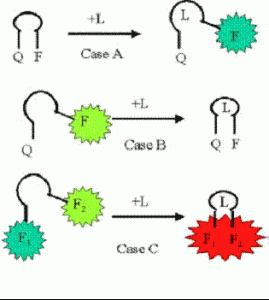Nucleic acid aptamers are oligonucleotides of modest size (~15-100 nucleotides) that can bind to a particular ligand with great affinity and selectivity. Ligands can range from metal ions to small organic molecules to proteins to viruses and even to bacterial cells. Aptamers are created and selected using a combination of synthetic chemistry, enzymology and interfacial chemistry involving affinity chromatography. Oligonucleotides not only have the ability to bind specific ligands, but also in some cases can catalyze a chemical reaction involving the ligand. In these cases the ligand becomes a substrate. A few RNA-based enzymes of this sort (ribozymes) exist in nature; for the most part these exhibit RNA-cleaving activity. DNAzymes that cleave RNA or DNA at specific sequences have also been isolated through selection and amplification.
We propose here to develop aptamer-based biosensors in which ligand binding is coupled to the action of a protein enzyme to effect an amplification of several orders of magnitude. We start with a known DNAzyme with copper-dependent DNase activity; this DNAzyme is capable of self-cleavage at a specific resident single-stranded sequence. Amplification is effected by using this self-cleaving DNAzyme to tether a protein protease molecule to a solid support on one side of a small well. Each time a copper ligand binds to a tether, it self-cleaves, releasing the protease. Also present in the well is a short fluorescence probe connected to gold disks and embedded in a medium compatible with exposure to aqueous environments. The released protease diffuses to the gold disk and cleaves the peptides, releasing a fluorescent signal.

